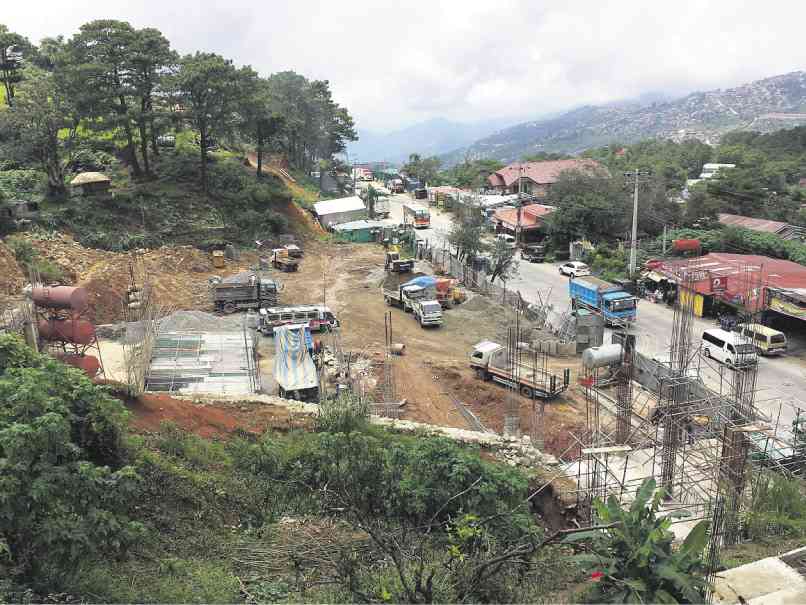Milking what’s left of Baguio Dairy Farm

Cattle being raised by a cooperative graze on the remaining pasture lands at the Baguio Dairy Farm which have not been invaded by illegal settlers. Without permits or clearances, informal settlements have sprouted at the portions of the dairy farm along the Marcos Highway (above). PHOTOS BY EV ESPIRITU
AGRICULTURE Secretary Emmanuel Piñol and the Department of Agriculture (DA) have been talking about plans to convert the Baguio Dairy Farm into a leading training and research facility for the country’s underdeveloped dairy industry.
Piñol informed Cordillera officials last week that he wanted to introduce high-end milking technology to the former Baguio Stock Farm, which was segregated for that purpose back in 1940.
During a July 28 briefing, Lorenzo Caranguian, DA Cordillera director, said the agency had found that the stock farm was suited for breeding cattle that would be distributed to farmers in the Cordillera, believing that providing rice farmers with farm animals would improve their lives.
True state of dairy farm
But not much details have been shared about the true state of the dairy farm.
Caranguian said DA’s vision would be enforced on 11 of 94 hectares of the reservation. The rest of the property had been invaded, partitioned and occupied by more than 300 settlers since 2013, claiming they were beneficiaries of a Certificate of Ancestral Land Title (CALT) issued to the heirs of Ikang Paus, an Ibaloy.
Bulldozers carved out new access roads, and trucks brought in materials to build concrete houses but Baguio residents saw no action from the DA, the city government or the police at the time.
In 2014, the Cordillera Regional Law Enforcement Coordinating Council had discussed the problem, after the police revealed that militiamen from the defunct Cordillera People’s Liberation Army were among the stock farm intruders. It also discussed an inventory of the settlers, who included migrants and local businessmen.
In 2015, former Agriculture Secretary Proceso Alcala inspected the reservation and announced that the DA would prosecute the squatters while working to nullify the CALT issued to Ikang Paus.
This year, the number of settlers has risen to 322 because a homeowners’ association there continues to sell lots, said Jesusa Delilah Guzman, one of DA’s agriculturists who inspected the farm last week.
“The settlers have no building permits, no environmental compliance certificates, no excavation permits. All they have is the CALT which the Office of the Solicitor General (OSG) had brought to the Supreme Court for cancellation,” she said.
The OSG had also petitioned a court for permission to enforce a writ of demolition. Its latest request was transmitted to the Supreme Court on April 27, Guzman said.
For the moment, the farm is managed by a dairy cooperative which has learned to live with their new neighbors. The Baguio Mountain High Dairy Cooperative tends to 30 cows to produce milk for Baguio residents, including families who remember the years when fresh milk was delivered to their homes.
But the expansion has started to encroach into remaining grazing land for the cooperative’s cattle, said Mary Macalintal, the cooperative’s administrative supervisor.
Piñol’s plans may help stave off these problems, Guzman said.
History
The idea of making the dairy farm a center for the dairy industry resonates well in the summer capital, primarily because of its history.
Baguio and the surrounding Benguet towns used to be territories of what anthropologist Dr. June Prill-Brett called a “bovine aristocracy” in the book, “Tradition and Transformation: Studies on Cordillera Indigenous Culture.”
This was a reference to the “baknang” (Ibaloy upper class and affluent), who controlled the gold trade before the country’s colonization and whose power was solidified with the introduction of cattle in the 1700s.
Much of what is now Baguio were pasture lands. In a University of the Philippines Baguio monograph, titled “Ibaloy Cattle Enterprise in Benguet,” retired economics professor, Bienvenido Tapang Jr., said cattle reshaped the Ibaloy society that was “more than prestige goods with both ceremonial and symbolic value.”
For example, the baknang sustained leadership by distributing cattle meat during ritual feasts—extending benefits to the average Ibaloy which “tended to even out income irregularities” in a stratified community, Tapang wrote.
Losing grip
The baknang lost its grip on power when the Americans created Baguio City in 1909. Many of its grazing lands became public lands and families soon relocated to the outskirts when sanitation laws banned cattle from inhabited sections of the city.
But at the beginning of American occupation, the Bureau of Agriculture established the stock farm “from where the more modern animal husbandry could have developed,” Tapang said.
He cited archival materials in 1905 which “pinpointed a range of country between Pacdal (in Baguio) and (the Benguet town of) Tublay … capable of supporting over 1,000 head [of cattle].”
The 1918 census also established the viability of the old Mountain Province (composing most of today’s Cordillera provinces) as “the chief cattle-raising region in the country,” which Tapang described as “stale news” for cattle-raising Ibaloy.
Unfortunately, he said, American development priorities were mining and urbanization.
Conflict
The dairy farm used to be called “Shuyo” or “Chuyo” and had become the subject of conflict among two contending Ibaloy clans, after the government was empowered to grant CALT in 1997, said Isabelo Cosalan Jr., a former Baguio councilor who chaired the city council’s committee on lands.
The CALT, a social reform instrument, may have been a reason for government’s apparent reluctance to nip the invasion of settlers in the bud.
But land speculation had also plagued the city before the CALT became a divisive issue, Cosalan said, especially in a city with skyrocketing real estate values. This is because almost two-thirds of Baguio is composed of inalienable government reservations. With a report from EV Espiritu, Inquirer Northern Luzon
